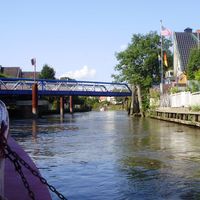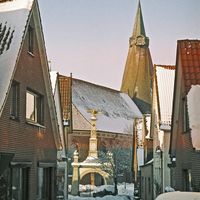53°51'81.3"N 9°73'81.1"E
Estebrügge
Iuxta Eschedam is mentioned in 1197, Eschete in 1221, Eskete in 1305, Eschede in 1376, to de Este in 1470...
In the Middle Ages, these names were used to refer to the linear settlements on both sides of the river Este that were established in the course of the Hollerkolonisation. The settlements extended from the Hinterdeich on the right bank of the Este (today Moorende) to Nienhusen (today near the Seehof at the end of Groß Hove) and on the left bank of the Este from the Hinterdeich to Leeswig; but not Cranz.
The name "Eschedebrügge" is documented since 1335. Initially, it only referred to the centre of the village near the St. Martini Church and the Este Bridge.
Due to the favourable location close to the only bridge (until 1875) across the Este downstream from Buxtehude, numerous merchants, skippers, craftsmen, tradesmen and innkeepers settled down here. Subsequently, the so-called Bürgerei (population) emerged with a small-town appearance and a unique, dense development on and along the dyke, typical for the bridge settlements in the Altes Land.
In the 14 th century new names appeared: Königreich for the northern part and Moorende for the southern part. These two terms became the names of the political "districts" of the so-called Hauptmannschaften.
Towards the end of the 15 th century, the name Estebrügge was used for the entire parish including Cranz and Nienhusen.
The Archbishop Heinrich III of Bremen maintained a mint in Estebrügge for a short time (1584/85).
The first documented mention of the Estebrügge market was in 1595. It takes place every year in September around the bridge in the centre of the village. Since a few years, the Estebrügger Heimatverein e.V. has taken over the organisation of the traditional market and many volunteers and associations participate. In the year of the Corona pandemic 2020, the market had to be cancelled.
The Estebrügger Schützengilde of 1612 has an equally long tradition.
Estebrügge was divided into the two main districts Königreich and Moorende for centuries. The border between the administrative districts was the Steinweg. The peasants were in the majority in the main communities and the tradesmen of the Estebrügge Bürgerei did not consider their interests to be adequately represented.
Negotiations began in 1852. After 27 years, Estebrügge became a separate political municipality. It comprised the densely populated Bürgerei on both sides of the Este.
The Este river not only divided the town in 1932, but also became the district border between Harburg and the district of Stade as a result of a district reform.
After a territorial reform in 1972, the Este municipalities except for Cranz and Neuenfelde were integrated into the municipality of Jork and belong to the district of Stade since then. Cranz and Rübke always remained in the parish of Estebrügge. The municipalities of Cranz and Neuenfelde belong to Hamburg since 1937. Rübke belongs to Lower Saxony; but to the district of Harburg.



